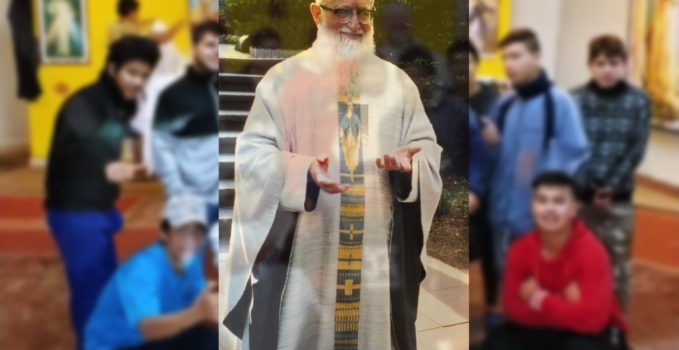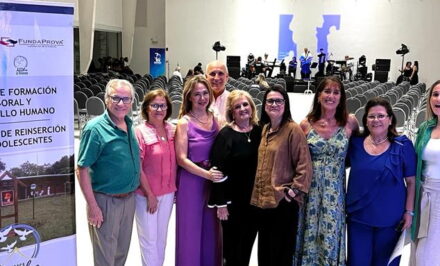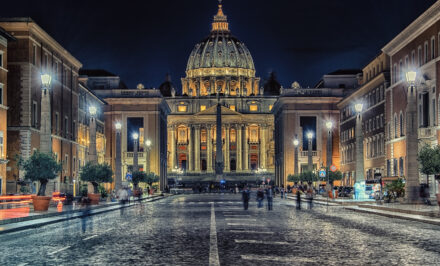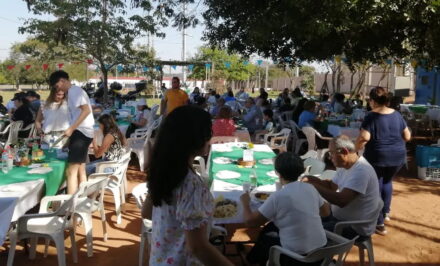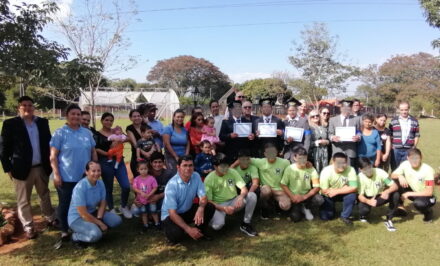Fr. Kentenich’s pedagogy on the peripheries (part 2) Fr. Pedro Kuehlcke •
We share the experiences and conclusions of Fr. Pedro Kuehlcke in the application of Fr. Kentenich’s pedagogy on the peripheries, concretely at a jail for minors and in the program for social reinsertion “Mother of Tupãrenda House”. It is about the second part of a text prepared for a conference for Schoenstatt Boys Youth of Tupãrenda. –
Pedagogy of confidence and movement
Father Kentenich speaks of the “stars of Schoenstatt’s pedagogy:” “In our pedagogy,” writes our Father and Founder – this is in 1950 – “we distinguish stars and fundamental forms. But I do not dare to take the time to explain this extensively.” [1]
Just as well because when Father “explains extensively,” it is about ten conferences to speak only about the first star. Ask Fr. Oscar, who has just finished a three-week course for the “Kentenich-Magister:” What conference did they get to the first star?
“The stars are the following: pedagogy of ideals, pedagogy of attachments, pedagogy of covenant, pedagogy of confidence, and pedagogy of movement. Five expressions with a rich, very rich content.”[2]
Does one of those five seem familiar? “Covenant,” “attachments,” “movement”… for some reason we are a Movement, and not a static structure, an institution. Does pedagogy of ideal seem familiar? Pedagogy of confidence? These are the five stars, and in some way, we live them (experience them) in Schoenstatt, even if we do not know the name, even if we have not heard speak of them explicitly.
 Pedagogy of Confidence
Pedagogy of Confidence
For example, let us analyze that star of confidence a bit. Father Kentenich says:
“First of all, it is about the enormously great and powerful confidence in the good there is in people, in human beings. Subsequently we have given this as a convincing and classic name: pedagogy of confidence.”[3]
I love that about Father; he has such a positive vision! Is there something good in you? Of course there is! Is there something good in a thief, in a thief on motorcycle? There the question gets very complicated… There is something good in everyone, even in those who do not know that!
Look at how our Father and Founder deepens that:
“If you would allow me to use a drastic expression, which I have used innumerable times when dealing with the Sisters: it is an art to overcome the black beetle in us on the dung heap and to cultivate the bee in us. Surely you understand what the phrase wants to say. We have to also give the other the right to his being. That is, to educate ourselves before anything else to see more in him the positive, what is valuable, than always pointing out on the first level what I do not like about him.”[4]
Dung heap black beetle – that typical little German bug that is always looking for rubbish; surely there is something similar over here. Do you see how when a cow drops something, all the flies and other bugs gather there?
In other words I can say: we can have the eyes of a fly, or the eyes of a bee. What happens if you let go a fly and a bee in a field? After a while, the fly comes and says: “This field is full of dung!” On the other hand, the bee comes and says: “This field is full of flowers!” But it is the same field. The fly sees the bad, the rubbish, the dung – the bee sees the flowers!
There are people who see everything with the eyes of a fly because they prefer to see the negative, the bad, the rubbish (dung). But there are also people who have learned to look with the eyes of a bee – they choose to see the good, the flowers. Both the positive and the negative are everywhere; I choose what I prefer to see.
There, in jail, we also try to always look with the eyes of a bee. Often we find youths whose lives are disasters: drug addicts, thieves on motorcycles, murderers… we find everything. There are youths who have done horrible things. When— generally for the first time in their life— they come clean and acknowledge everything, they become aware that their heart seems like a hard rock, cold and dark, full of shame and contempt for themselves— sometimes with tremendous emptiness born of loneliness and suffering, sometimes with an ocean of tears, they were never able to let go— and all is very well hidden behind the mask of a hard macho and a false smile.
And do you know what I tell them? “You have a heart of gold!” The youth looks at me with a face as if he wants to say: “What’s this priest talking about? If I just told him about the total disaster I have made of my life?” I insist: “Did you know you had a heart of gold?” “No, I did not know! Nobody ever told me something like this.”
Why a heart of gold? And then you have to explain to him a little bit on how you discovered his heart of gold. For example: he got the courage to speak with a priest, something he had never done in his life; he got the courage to acknowledge what he had done… Where did he get that confidence to talk about that which he had never before told anyone? Not from the heart of stone, but from the heart of gold. Where does it come from for him to say: “I really did some very bad things, I need to ask God’s forgiveness, and also my victims, I need to change?” From the heart of gold! That heart which wants to shine, but was covered by a great deal of rubbish…
To help another to discover that he has something good, that is pedagogy of confidence. And that works, that changes lives!
One of the boys had told me that his entire family was into crime: the grandmother was a drug trafficker, the mother is a “pickpocket,” the father is a robber and killer… All have spent or are spending a lot of time in jail. And one thinks: “Of course, what could that boy have learned in his whole life?” When his mother got mad with him, which was quite often, she would tell him that he was going to be like his father, and then that he also had to be a robber, a killer, a jailbird remained in his sub-conscience: he did not imagine any other alternative. When I told him about his heart of gold, it was like a revelation for him: “I can be different, I can change the history of my family!” He is now participating in catechism, because he wants to be baptized and to be a good child of God. The other day, he proudly told me: “Priest, I already know almost all of the Creed by heart! When are you going to baptize me?”
Do you know boys that go through the world cultivating their inferiority complex? “I’m not good for anything; I can’t; no, better to ask someone else…” When someone is asked to say a prayer at the beginning of a meeting: “No, I don’t know how to pray.” “How?” Or to be in charge of the group: “No, better someone else who is more prepared, I’m not good at that.” Inferiority complex completely! We all know, obviously! We all have hearts of gold; we all have something good. Father Kentenich teaches us to look for and find the good in ourselves and in others— being aware, we manage to close our fly eyes, and open our bee eyes. In our dealing with our neighbor, conscientiously seek the positive. That, I can assure you, changes lives!
I remember a youth sent me a message a long time after he exited the CEI. He told me he had fallen into drugs again, he had stolen, I don’t know what else he did… The police got him, and since he was already 18, they sent him to jail for adults: everything is far more complicated there than at CEI! It is forbidden to have a cellphone in all jails, but sometimes they manage to find a way to have one for a while. That was, more or less, the dialogue in his message: “Hello, priest, it’s been a long time! How are you?” “All is well, and you?” “All is ok also!” I answered him head on: “Liar! Where are you?” “In jail once again.” “Seriously, what happened to you?” “I fell again.” “How are you now?” “So, so but I’m struggling.” “And do you really want to change?” “Yes, priest! I always remember that you told me I had a heart of gold.” Look that conversation had been more than a year before, but the boy perfectly remembered someone at sometime had told him he had a heart of gold. And even though he fell, and even though he turned his life into a disaster again, that remained: the heart of gold and a desire to strive and overcome in spite of everything.
Are you aware how important this pedagogy of confidence is? For example, I was with a group and someone told me: “Really I would like to help in something like this, but I can’t decide to because I don’t know if it will turn out well.” But clearly, of course, go on… get into it, do it! Are you going to make mistakes? Of course! Nobody is born with the guarantee of never making mistakes. But just the same, you can do it!”
Pedagogy of confidence: to give confidence to another, to see the good in another—this comes from having confidence in oneself and believing that one was also born with a heart of gold.
Pedagogy of movement
Afterwards Father also spoke of the pedagogy of movement that has a great deal to do with the pedagogy of confidence. “Pedagogy of movement,” what does it mean?
Father Kentenich tells us in a very concrete form:
Let us take a “look into the interior of a kingdom that is ruled by the pedagogy of movement. Although there is a lot of low tide and high tide and the currents frequently crash in their confines, the health of the psychic disposition finds in all places – in due time – the point for repose and equilibrium.”[5]
Everything clear? Let’s begin to translate…
Who of you was at one time on vacation by the sea, at the beach, in Brazil, in Chile? Something happens in the sea which normally does not happen so much in the river – in the river it happens once a year, but in the sea, it happens everyday: the water rises, “high tide;” and suddenly it again goes down, “low tide;” sometimes at night, sometimes during the day, because that depends on the moon. In the river, it depends on something else: when it rains, the river rises, and you have the typical floods of our neighborhoods on the outskirts.
High tide and low tide: not only in the sea or in the river, that happens in many aspects of life. Sometimes things rise, they grow, everything is OK, and sometimes they go down, everything is drought, disaster. But with time, Father Kentenich would say, something channels, finding equilibrium. For example, our Schoenstatt Boys Youth: one year everything is really good, five new groups, school for leaders, consecrations for ten members, fantastic! And the next year? We go down, nothing is left, disaster— let’s shoot ourselves, everything is finished! No, we’re not going to shoot ourselves! We are going to continue striving because at some moment the high tide will return, the situation will change. Father Kentenich calls that “pedagogy of movement;” We go, we come, some leave, some again appear after years… Is that not true? There is a lot of movement. It’s not that we advance all at the same rate like in school: first course, second course, third course. Each one grows in his own way, sometimes through very, winding ways — and suddenly, the boy you least expect is kneeling in the front of the Shrine sealing his Covenant of Love.
“The pedagogy of movement leads through the way of the Movement to clearly recognized aims.”[6]
For example: this group now has to do a certain thing, but they say: “No, we want to do this!” “Perfect, they are free, you decide.” But the great objective, the clearly recognized aim is the Covenant of Love – through the way you choose. If we are in Schoenstatt it is because we want to attach ourselves to the Shrine, to the Blessed Mother and to the Father and Founder. If a group comes and says: “No, that bit about the Covenant of Love and of praying and going to Mass on Sundays, that does not go with us!” then perfect, then go to groups like Techo or Rotary, or look for something else. In Schoenstatt, we have a clear aim: we are a religious group, we want to seal the Covenant of Love… we have a clear aim, but the way can have many changes. That means pedagogy of movement.
The more you contemplate all of these things, the more you will be convinced of how much personal freedom reigns and erupts everywhere, much more than in other communities.”[7]
Many other Movements are far more “structured:” First you have to do this, then this other, then this, and thus. In Schoenstatt we have that marvelous freedom of following one’s own way— but towards that clearly recognized aim.
Father continues saying: “While there is a clear head that sees everything connected and that a firm hand is over everything, without wanting to placate the waves of the times…”[8] It is not about a “barracks order!” “Do you want to do that? No, now we have to do this, period, end of discussion!” No, on the contrary: Do it your own way, experiment!
It is what we experience in the Schoenstatt Men’s Youth, and it is also what we experience in jail: pedagogy of movement!
For example, I remember a youth who got out of jail, he came here to our Mother of Tupãrenda House program, he started well for one or two months. Suddenly, one weekend, what happened? I found him again in jail on Monday. “What happened to you, you were doing so well?” “I met up with some friends…” “Your bad group?” “Yes, Priest. We started to drink beer, then vodka. Someone brought marijuana, then we wanted to smoke something stronger.” “And how did you pay for all of that?” “I fell into temptation, I went to steal a cellphone, the police caught me, and here I am again.”
What would you say? “What a disaster, forget it, you aren’t good for anything!” No! I told him: “Ok, now you are going to be for a time here in jail, you are going to cultivate your heart of gold again, and when you get out, if you really want to get ahead with your life, I will expect you back in Tupãrenda.” That boy has now graduated from Mother of Tupãrenda House. He fulfilled his nine months very well— on his second try! —And he is working professionally in a bakery, with a set contract, regular salary, and social security. But if this boy had not been told: “Ok, you messed up, it’s done, but I have confidence in you, you can do it, continue striving!” perhaps today he would be in some other jail or an even worse place.
Do you understand? That is pedagogy of movement: make your way; commit your mistakes, no problem! But we have an objective—we want to succeed— or in the Boys Youth we would say: “We want to seal a Covenant of Love, we want to be good children of God and the Blessed Mother.”
Pedagogy of confidence and of movement: I mentioned them first on purpose because they are a bit less known, but they are the ones that we truly experience, or at least want to experience. The problem with these two stars is that they complicate our life. For example, when at a meeting of the leaders of the Boys Youth, they are analyzing how each group is doing: “This group is a disaster – now they have thought of I don’t know what…” “But how fantastic, I love it, forward! But are they going to want to seal the Covenant of Love at some moment, or not?”
“Mess things up, make a fuss!” Pope Francis would say. Do you remember his visit to Paraguay, the encounter with the youths at la Costanera? There he added: “Make a fuss, but organize it well!” That translated is pedagogy of movement and of confidence. And it complicates life. It would be much easier to have everything well ordered, in squares, a flowchart here, an outline there, but life is not that way. Life is disorderly, but life has to always have an objective.
Official website of HouseMother of Tuparenda, now also in english : www.fundaprovapy.org
Kentenich Pedagogy on the Periphery – 2 – complete text as pdf
Photos: Maria Fischer @schoenstatt.org
[1] All quotes refer to Herbert King (ed). José Kentenich: Volumen 5: Textos pedagógicos Ed. Nueva Patris, Santiago de Chile, 2008, a Spanish translation of the German “Joseph Kentenich. Ein Durchblick in Texten, Bd 5, Pädagogische Texte” by the same editor. Cited as “King.” Pg. 119
[2] King, 119.
[3] King, 208.
[4] King, 215.
[5] King, 314.
[6] King, 312.
[7] King, 315.
[8] Íd.
Original: Spanish. March 10, 2019. Translation: Carlos Cantú, Austin, Texas USA. Edited: Melissa Peña-Janknegt, Elgin, TX USA


